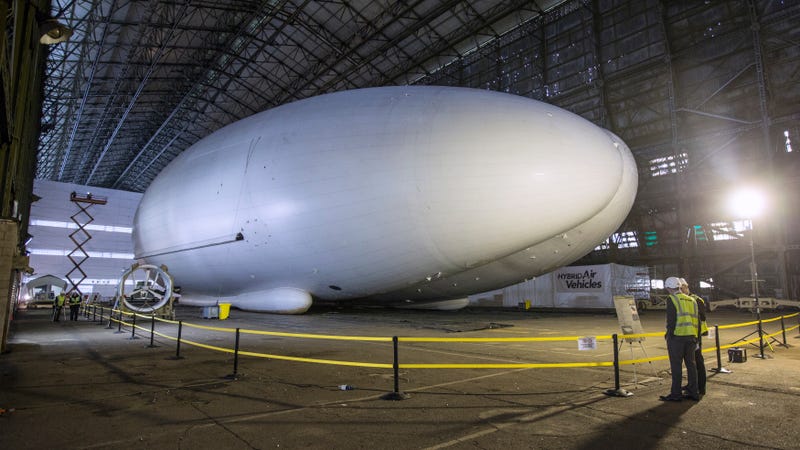 Hybrid Air Vehicle’s Airlander aircraft, pictured here in an airship shed in Cardington, England, in 2010.Photo: Oli Scarff (Getty Images)
Hybrid Air Vehicle’s Airlander aircraft, pictured here in an airship shed in Cardington, England, in 2010.Photo: Oli Scarff (Getty Images)
Hybrid Air Vehicles, the company behind the Airlander 10 airship (the world’s longest aircraft and also known as the “flying bum” for its resemblance to a butt), said on Sunday that its current prototype will not be rebuilt but that it plans to build a new generation of airships, the Guardian reported.
HAV, which is based in Bedford in the UK, has already received the approval of the Civil Aviation Authority for a new line of airships slated for the early 2020s, the Guardian wrote. The paper quoted its CEO Stephen McGlennan as saying:
“Our focus is now entirely on bringing the first batch of production-standard, type-certified Airlander 10 aircraft into service with customers,” said Stephen McGlennan, the company’s chief executive.
“The prototype served its purpose as the world’s first full-sized hybrid aircraft, providing us with the data we needed to move forward from prototype to production-standard. As a result, we do not plan to fly the prototype aircraft again.”
HAV describes the 302-foot (92 meter) Airlander 10 on its website as combining the “best characteristics of fixed wing aircraft and helicopters with lighter-than-air technology to create a new breed of hyper-efficient aircraft.” Constructed out of carbon fiber, kevlar, and mylar, and remaining aloft on inert helium, the craft was co-developed by HAV and Northrop Grumman for the U.S. Army’s experimental Long Endurance Multi-intelligence Vehicle (LEMV) program and dubbed the HAV 304.
LEMV was later canceled by the military and the airship was repurchased by HAV, transferred back to one of its facilities in Cardington, and converted into the Airlander 10, a civilian model. According to the Guardian, it has achieved altitudes of 7,000 feet (2,134 meters) and a top speed of 50 knots.
Beyond its size and butt-like appearance, the Airlander 10 is also known for accidents during its two of its six test flights. In August 2016, the airship crashed after taking off from RAF Cardington airfield in Bedfordshire. In November 2017, the craft tore free of its moorings before ripping open, with the firm saying the resulting deflation was the result of automatic safety features designed to bring it down if it broke free of its mast. One person suffered minor injuries in the latter incident.
According to the Guardian, HAV had to abandon plans to use the Airlander 10 prototype as a “test article and sales demonstrator” after the latter incident, though it won over $25 million (20 million pounds) in insurance payouts for the “very significant damage” to the airship. McGlennan stated that HAV is now focused on moving forward to a production-ready Airlander model, including “all the details that make the difference between a prototype and a product.” The Guardian added that HAV appears to be quickly moving through the regulatory process:
The company, founded in 2007, added it was in a “strong position to launch production” of the new aircraft, with the design already approved by the European Aviation Safety Agency.
It said that it usually takes more than a year to prepare a facility for a CAA production organisation approval audit, but the Airlander Technology Centre was audit-ready within six months.
As the Verge noted, in addition to whatever successor is planned for Airlander 10, HAV is also planning an Airlander 50 model it describes as its “big brother,” capable of carrying 55 U.S. tons.
[The Guardian via the Verge]
Share This Story